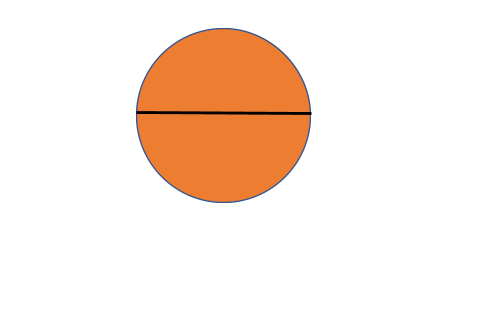What is a Decimal Number?
A decimal number is a number that consists of a whole number and a fractional part. The point separates the whole number from the fractional part. For example, 56.78 is a decimal number.

What is a Fraction?
A fraction represents a part of the whole, more generally any number of equal parts. It consists of two parts. The number above the line is called the numerator and the number below the line is called the denominator. For example, in the given figure the fraction is 12.

What is a Decimal Fraction?
In algebra, a decimal fraction is a fraction whose denominator is 10 or a multiple of 10 like 100, 1000, 10000, etc. For example, 310 is a decimal fraction which is equivalent to 0.3.
Steps to Convert Decimal to Fraction
The steps given below shows how to convert decimal to fraction:
- Identify the place value of the last digit after the decimal in the number
- Use it to determine the denominator of the number
- Remove the decimal point and rewrite it in the fraction form
- Then reduce the fraction into its simplest form
Let us take an example to understand it better.
Example: Convert 0.25 into a fraction.
- Identify the place value of the last digit🡪 5 is in the hundredth place
- Therefore, the denominator of the number will be 100
- In fraction form 🡪25/100
- After simplifying it into the lowest equivalent fraction, we get 1/4
Steps to Convert Repeating Decimal into Fraction
Repeating decimals are those that do not terminate after a finite decimal place and a digit or digits keep on repeating itself. Let us take an example,
Example: Convert 0.3333… to fraction.
Here the recurring digit is 3.
Let x = 0.3333…
Multiplying 10 on both sides,
10x = 3.3333…
Subtracting both the equations,
9x = 3
x = 13.
Steps to convert decimal to mixed fraction number
Mixed fractions are those whose values are greater than 1. Decimal numbers whose values are greater than 1 can be written in the form of mixed fraction numbers. The steps are as follows:
- Take the whole number and the decimal part separately
- Check the place value of the last digit of the decimal number
- Use it to determine the denominator of the number
- Now write the whole number ignoring the decimal point in the form of a fraction
- Reduce it to the simplest form
- This will be the required form of the mixed fraction number
Example: Convert 4.5 into a fraction.
- Place value of the last digit 🡪 tenth place
- Denominator of the number is 10
- In fraction form 🡪 45/10
- Simplest form 🡪 9/2
- Mixed fraction for 🡪4 1/2
Steps to convert fraction to decimal
Case 1: If the denominator present in the number is 10 or multiple of 10.
Count the number of zeros in the denominator, then put the decimal point from the right by the same count. For example, if the fraction is 2100 then the number of zeros in the denominator is two. Then place the decimal point from two digits starting from the right. Hence, the answer will be 0.02.
Case 2: If the denominator is not a multiple of 10.
This can be treated as a simple division. For example, if 25 is to be converted from fraction to decimal. This can be simply seen as 2 ÷5. Hence, the answer comes out to be 0.4.
Conclusion
Through this guide, we got to know about decimal numbers, fractions, decimal fractions, and their conversion to one another. Decimal numbers consist of whole numbers and fractional parts. Fraction number consists of a numerator and denominator. A decimal fraction is a fraction whose denominator is 10 or a multiple of 10.
 Profile
Profile Settings
Settings Refer your friends
Refer your friends Sign out
Sign out






